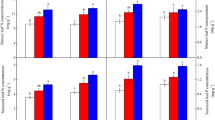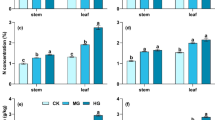Abstract
Salix gracilistyla is one of the dominant plants in the riparian vegetation of the upper-middle reaches of rivers in western Japan. This species colonizes mainly sandy habitats, where soil nutrient levels are low, but shows high potential for production. We hypothesized that S.␣gracilistyla uses nutrients conservatively within stands, showing a high resorption efficiency during leaf senescence. To test this hypothesis, we examined seasonal changes in nitrogen (N) and phosphorus (P) concentrations in aboveground organs of S. gracilistyla stands on a fluvial bar in the Ohtagawa River, western Japan. The concentrations in leaves decreased from April to May as leaves expanded. Thereafter, the concentrations showed little fluctuation until September. They declined considerably in autumn, possibly owing to nutrient resorption. We converted the nutrient concentrations in each organ to nutrient amounts per stand area on the basis of the biomass of each organ. The resorption efficiency of N and P in leaves during senescence were estimated to be 44 and 46%, respectively. Annual net increments of N and P in aboveground organs, calculated by adding the amounts in inflorescences and leaf litter to the annual increments in perennial organs, were estimated to be 9.9 g and 0.83 g m−2 year−1, respectively. The amounts released in leaf litter were 6.7 g N and 0.44 g P m−2. These values are comparable to or larger than those of other deciduous trees. We conclude that S. gracilistyla stands acquire large amounts of nutrients and release a large proportion in leaf litter.
Similar content being viewed by others
References
Boerner REJ (1984) Foliar nutrient dynamics and nutrient use efficiency of four deciduous tree species in relation to site fertility. J Appl Ecol 21:1029–1040
Bollmark L, Sennerby-Forsse L, Ericsson T (1999) Seasonal dynamics and effects of nitrogen supply rate on nitrogen and carbohydrate reserves in cutting-derived Salix viminalis plants. Can J Forest Res 29:85–94
Bray RH, Kurtz LT (1945) Determination of total, organic, and available forms of phosphorus in soils. Soil Sci 59:39–45
Bremner JM (1965) Inorganic forms of nitrogen In: Black CA (ed) Methods of soil analysis. American Society of Agronomy, Inc., Publisher, pp 1179–1237
Brunet RC, Astin KB (1996) Variations in mineral nitrogen levels: the River Adour. Hydrobiologia 335:159–170
Chapin FS III, Kedrowski RA (1983) Seasonal changes in nitrogen and phosphorus fractions and autumn retranslocation in evergreen and deciduous taiga trees. Ecology 64:376–391
Chapin FS III, Tryon PR (1983) Habitat and leaf habitat as determinants of growth, nutrient absorption, and nutrient use by Alaskan taiga forest species. Can J Forest Res 13:818–826
Chapin FS III, Johnson DA, McKendrick JD (1980) Seasonal movement of nutrients in plants of differing growth form in an Alaskan tundra ecosystem: Implications for herbivory. J Ecol 68:189–209
Cooper DJ, van Haveren BP (1994) Establishing felt-leaf willow from seed to restore Alaskan, U.S.A., floodplains. Arctic Alpine Res 26:42–45
Escudero A, del Arco JM, Sanz IC, Ayala J (1992) Effects of leaf longevity and retranslocation efficiency on the retention time of nutrients in the leaf biomass of different woody species. Oecologia 90:80–87
Grigal DF, Ohmann LF, Brander RB (1976) Seasonal dynamics of tall shrubs in northeastern Minnesota: Biomass and nutrient element changes. Forest Sci 22:195–208
Harner MJ, Stanford JA (2003) Differences in cottonwood growth between a losing and a gaining reach of an alluvial floodplain. Ecology 84:1453–1458
Hiroshima Local Meteorological Observatory (2002) Weather in Hiroshima Prefecture (2001). Hiroshima Local Meteorological Observatory, Hiroshima Japan (in Japanese)
Ishikawa S (1988) Floodplain vegetation of the Ibi River in central Japan. I. Distribution behavior and habitat conditions of the main species of the river bed vegetation developing of the alluvial fan. Jpn J Ecol 38:73–84 (ln Japanese with English summary)
Ishikawa S (1996) The ecological characteristics of riparian plants. In: Okuda S, Sasaki Y (eds) River environment and riparian plants. Soft Science Inc., Tokyo Japan, pp 116–139. (in Japanese)
Japanese Industrial Standards Committee (1998) Japanese industrial standard: Testing methods for industrial water JIS K 0101: 140–141. Japanese Standards Association, Tokyo, Japan. (in Japanese)
Johnson FL, Risser PG (1974) Biomass, annual net primary production, and dynamics of six mineral elements in a post oak-blackjack oak forest. Ecology 55:1246–1258
Kawahara T (1971) The return of nutrients with litter fall in the forest ecosystems (II) The amount of organic matter and nutrients. J Jpn Forest Soc 53:231–238 (in Japanese with English summary)
Killingbeck KT (1984) Nitrogen and phosphorus resorption dynamics of five tree species in Kansas galley forest. Am Midl Nat 111:155–164
Luyssaert S, Staelens J, de Schrijver A (2005) Does the commonly estimator of nutrient resorption in tree foliage actually measure what it claims to? Oecologia 144:177–186
Miyawaki A (ed) (1983) Vegetation of Japan, vol 4. Chugoku. Shibundo, Tokyo, Japan (in Japanese)
Miyawaki A (ed) (1984) Vegetation of Japan, vol 5. Kinki Shibundo, Tokyo Japan (in Japanese)
Murphy J, Riley JP (1962) A modified single solution method for the determination of phosphate in natural waters. Anal Chim Acta 27:31–36
Naiman RJ, Fetherston KL, Mckay SJ, Chen J (1998) Riparian forests. In: Naiman RJ, Bilby RE (eds) River ecology and management. Springer-Verlag, New York USA, pp 289–323
Nakatsubo T (1997) Effects of arbuscular mycorrhizal infection on the growth and reproduction of the annual legume Kummerowia striata growing in a nutrient-poor alluvial soil. Ecol Res 12: 231–237
Nihlgård B (1972) Plant biomass, primary production and distribution of chemical elements in a beech and a planted spruce forest in South Sweden. Oikos 23:69–81
Ralhan PK, Singh SP (1987) Dynamics of nutrients and leaf mass in central Himalayan forest trees and shrubs. Ecology 68:1974–1983
River Bureau, Ministry of Land, Infrastructure and Transport (2004) Water Quality Table (2001). Kantou Kensetsu Kohsaikai, Saitama, Japan. (in Japanese)
Rytter R-M (2001) Biomass production and allocation, including fine-root turnover, and annual N uptake in lysimeter-grown basket willows. Forest Ecol Manage 140:177–192
Sakio H, Masuzawa T (1992) Ecological studies on the timberline of Mt. Fuji. III. Seasonal changes in nitrogen content in leaves of woody plants. Bot Mag Tokyo 105:47–52
Sasaki A, Nakatsubo T (2003) Biomass and production of the riparian shrub Salix gracilistyla. Ecol Civil Eng 6:35–44
Sasaki A, Fujiyoshi M, Shidara S, Nakatsubo T (2001). Effects of nutrients and arbuscular mycorrhizal colonization on the growth of Salix gracilistyla seedlings in a nutrient-poor fluvial bar. Ecol Res 16:165–172
Singh B (1998) Biomass production and nutrient dynamics in three clones of Populus deltoides planted on Indogangetic plains. Plant Soil 203:15–26
Small E (1972) Photosynthetic rates in relation to nitrogen recycling as an adaptation to nutrient deficiency in peat bog plants. Can J Bot 50:2227–2233
Smith SE, Read DJ (1997) Ectomycorrhizas. In: Smith SE, Read DJ (eds) Mycorrhizal symbiosis, 2nd edn. Academic Press, California, USA, pp 161–289
Stachurski A, Zimka JR (1975) Methods of studying forest ecosystems: leaf area, leaf production and withdrawal of nutrients from leaves of trees. Ekol Pol 23:637–648
Turner J, Cole DW, Gessel SP (1976) Mineral nutrient accumulation and cycling in a stand of red alder (Alnus rubra). J Ecol 64:965–974
van Heerwaarden LM, Toet S, Aerts R (2003) Current measures of nutrient resorption efficiency lead to a substantial underestimation of real resorption efficiency: facts and solutions. Oikos 101:664–669
von Fricks Y, Ericsson T, Sennerby-Forsse L (2001) Seasonal variation of macronutrients in leaves, stems and roots of Salix dasyclados Wimm. grown at two nutrient levels. Biomass Bioenerg 21:321–334
Acknowledgements
We thank A. Ogura, E. Ohta, Y. Haino and the National Science Center for Basic Research and Development, Hiroshima University for measuring the nitrogen concentration of the samples.
Author information
Authors and Affiliations
Corresponding author
Rights and permissions
About this article
Cite this article
Sasaki, A., Nakatsubo, T. Nitrogen and phosphorus economy of the riparian shrub Salix gracilistyla in western Japan. Wetlands Ecol Manage 15, 165–174 (2007). https://doi.org/10.1007/s11273-006-9012-8
Received:
Accepted:
Published:
Issue Date:
DOI: https://doi.org/10.1007/s11273-006-9012-8




